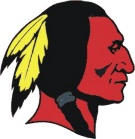Redface! |
 |
History of Indian (Native American) StereotypesBefore Columbus arrived in the "New World" there were no Indians, and the only reason he called them Indians was because at first he thought he had landed in India. The indigenous peoples of North America certainly didn't call themselves Indians, and they did not even think of themselves as one people. At the beginning of European immigration, there were over 300 distinct Indian languages in North America. But through stereotyping, the White European imposed a collective identity upon the Indians. And it was in the process of being stereotyped by whites, that Indians began to think of themselves as one race. What it meant to be an Indian was defined by Whites and imposed upon Native Americans. Even the common names of Indian tribes -- Navajo, Sioux, Cheyenne, Blackfoot, etc. -- are usually the names whites gave them, and those names were rarely complementary. Throughout American history the perceptions of Native Americans changed in response to the natives' usefulness to Whites. When the early colonists needed them to stay alive or help fight a war, the Indians were thought of as brave and noble savages. When the Indians got in the way and threatened the White Man's plans, they became animalistic and bloodthirsty savages. The Indian, who had been important when trade and exploration were the keys to overseas involvement, became an inconvenient obstacle to settlement of the lands to the West. During the course of the seventeenth century many Indians tried to assimilate into white society. Over the years they became dependent upon the modern tools brought by the European -- the knife, gun, kettle, and fish-hook. Gradually those Indians who stayed on the Eastern Seaboard lost their forest skills. Their culture slowly changed under the pressure of contact with a more technologically advanced society that had little use for them except as day laborers. Unlike his brother on the frontier, the dreaded "savage," the domesticated Indian was usually looked upon with contempt. During the 18th and 19th centuries, the West was considered a wilderness ripe for exploration and economic development, and the region's inhabitants were envisioned as part of a natural order to be overcome in the name of progress. To justify their depredations against the Indians, Americans created a self-justifying rationalization; as inferior beings, Indians were destined to vanish off the face of the earth. The stereotype of the hostile savage helped assuage a sense of guilt which inevitably arose when men whose culture was based on the concept of private property embarked on a program to dispossess another people of their land. Having created the conditions in which the Indian could only respond violently, Americans defined the native as brutal, beastly, savage, and barbarian and then used that as a justification for the genocide that followed. "I don't go so far as to think that the only good Indian is the dead Indian, but I believe nine out of every ten are, and I shouldn't like to inquire too closely into the case of the tenth. The most vicious cowboy has more moral principle than the average Indian." |

Buy a No
Soliciting Sign
That Really Works!
|
|
|
|
|
Redface! -- ContentsRacist Indian StereotypesHistory of Indian StereotypesRedface in Film and TVIndian Myths vs RealityIndian Stereotypes in Sports |
|
|
|||||
|
|
|
|
|
|
|
Racial and Racist Stereotypes in Media |
|||||
|
|
|||||